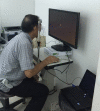Sensitivity and Specificity of New Visual Field Screening Software for Diagnosing Hemianopia
- PMID: 34512063
- PMCID: PMC8412821
- DOI: 10.2147/EB.S315403
Sensitivity and Specificity of New Visual Field Screening Software for Diagnosing Hemianopia
Abstract
Purpose: To assess the diagnostic accuracy of visual field results generated by the newly developed software (CU-VF) and the standard automated perimetry (SAP) for detecting hemianopia.
Patients and methods: Forty-three subjects with hemianopia and 33 controls were tested with the CU-VF software on a personal computer and SAP. Hemianopia was defined as the presence of a hemianopic field respecting the vertical meridian on SAP with the corresponding neuroimaging pathology as evaluated by 2 neuro-ophthalmologists. Results of CU-VF were independently evaluated by 2 neuro-ophthalmologists, 1 general ophthalmologist, and 1 general practitioner in terms of the presence of hemianopia. Sensitivity, specificity, and kappa coefficient for inter-observer reliability were calculated. Satisfaction and ease of use were evaluated with a visual analog-scale questionnaire and analyzed using paired t-test.
Results: The sensitivity (95% CI) and specificity (95% CI) of the CU-VF to detect hemianopia was 74.42% (58.53-85.96) and 93.94% (78.38-99.94). Kappa coefficient between neuro-ophthalmologists versus general ophthalmologist and general practitioner were 0.71 and 0.84, respectively. The mean (SD) test duration was 2.25 (0.002) minutes for the CU-VF and 5.38 (1.34) minutes for SAP (p < 0.001). Subjects reported significantly higher satisfaction and comfort using the CU-VF software compared to SAP.
Conclusion: The CU-VF screening software showed good validity and reliability to detect hemianopia, with shorter test duration and higher subject satisfaction compared to SAP.
Keywords: hemianopia; screening software; visual field.
© 2021 Jariyakosol et al.
Conflict of interest statement
The authors report no conflicts of interest in this work.
Figures





References
-
- Hepworth L, Rowe F, Walker M, et al. Post-Stroke visual impairment: a systematic literature review of types and recovery of visual conditions. Ophthalmic Res. 2016;5:1–43.
LinkOut - more resources
Full Text Sources
Miscellaneous

